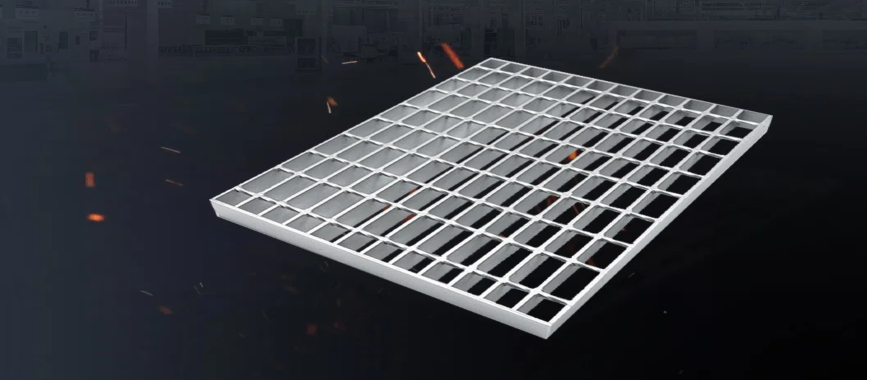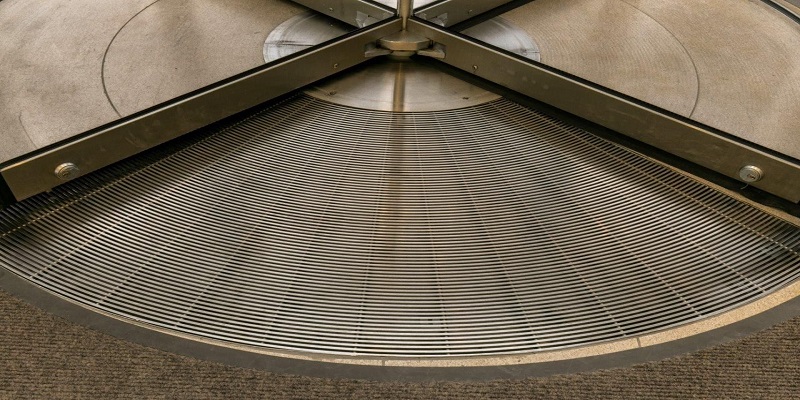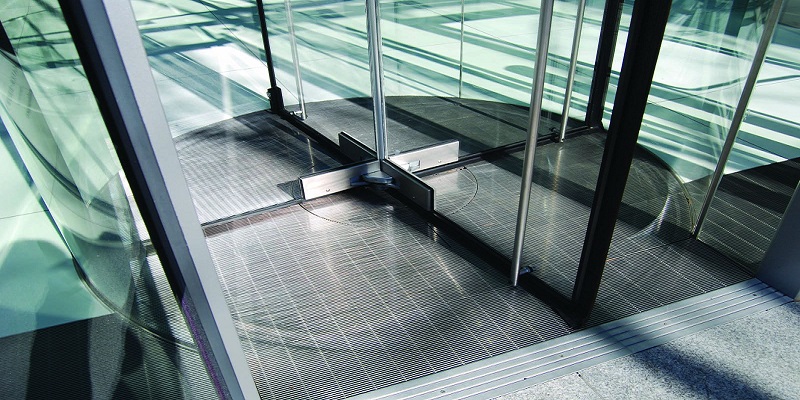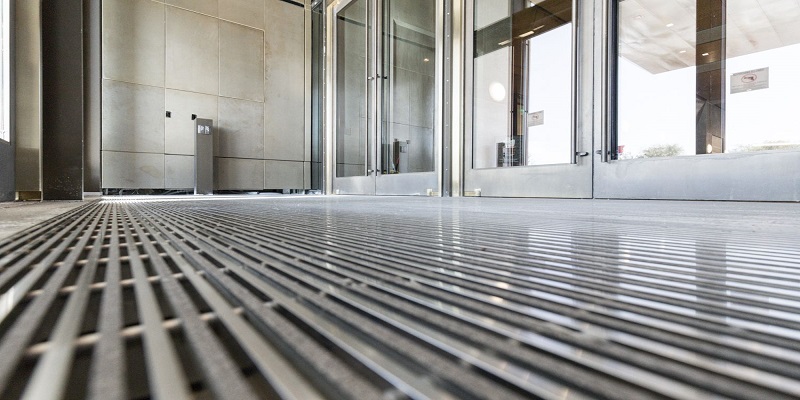
Entrance grating plays a vital role in modern flooring, offering both functionality and aesthetic appeal. It enhances safety by controlling debris and preventing slips at building entrances. Public, commercial, and industrial spaces benefit from entrance grating as it helps maintain cleanliness and reduces maintenance efforts. These systems also improve indoor air quality by trapping dirt at the entry points.Various materials are used to manufacture entrance grating, including stainless steel, aluminum, and galvanized metals. Each material offers unique properties, such as corrosion resistance and durability, making them ideal for high-traffic areas. Entrance grating is also available with different finishes and coatings, including anti-slip surfaces, ensuring safer walkways for visitors and employees. Entrance grating is a durable, aesthetic solution that removes dirt, moisture, and debris, protecting buildings from environmental contaminants.
What Are Entrance Floor Gratings
Entrance grating plays a vital role in modern building designs, balancing aesthetics with functionality. These systems ensure safe and clean environments by preventing dirt, moisture, and debris from entering indoor spaces. With a wide range of applications, entrance floor gratings are designed to enhance the user experience while reducing maintenance efforts. Their versatility makes them suitable for various public, commercial, and industrial environments, ensuring long-term performance and safety.

How Entrance Floor Gratings Contribute to Dirt Control and Safety
Entrance grating plays a crucial role in managing dirt and improving safety. The design ensures that dust, mud, and moisture stay outside the building, protecting indoor floors. Benefits include:
- Reduced cleaning efforts: Gratings trap dirt at the entrance, minimizing the need for frequent cleaning inside.
- Improved air quality: By controlling outdoor contaminants, these systems help maintain healthier indoor environments.
- Slip-resistant surfaces: Many entrance floor gratings include anti-slip finishes, ensuring safe footing in all weather conditions.
- Minimized floor damage: By capturing abrasive dirt, grating systems prevent scratches and wear on interior flooring.
Suitable Materials for Entrance Floor Gratings in Various Settings
Selecting the appropriate material for entrance floor gratings is crucial for ensuring that they perform effectively under various environmental and traffic conditions. The right material not only affects the functionality of the grating but also its lifespan, appearance, and safety features. Below is a more in-depth exploration of the most commonly used materials for entrance floor gratings:
Stainless Steel
Stainless steel is one of the most popular materials for entrance gratings, especially in high-traffic areas or environments where longevity and resistance to environmental factors are key concerns. Stainless steel is known for its exceptional strength, making it capable of withstanding heavy foot traffic and heavy loads. Additionally, its resistance to corrosion and rust is unmatched, making it ideal for outdoor or coastal areas where moisture, salt, and humidity can cause wear on other materials. Aesthetic appeal is another benefit of stainless steel, as it offers a sleek, modern appearance that suits most commercial or industrial buildings. The main disadvantage of stainless steel is its higher initial cost compared to other materials, but its durability makes it a cost-effective choice in the long run.
Applications: High-traffic commercial buildings, malls, airports, hospitals, industrial facilities, outdoor entrances.
Aluminum
Aluminum is a lightweight material that offers excellent corrosion resistance, making it a popular choice for moderate traffic areas. Aluminum gratings are known for their easy handling and quick installation, which makes them cost-effective both in terms of material cost and labor. Although aluminum is not as strong as stainless steel, its lightness makes it ideal for situations where the grating needs to be easy to handle or move. It is also recyclable, contributing to its sustainability in modern building practices. Aluminum is highly resistant to oxidation, which makes it suitable for environments exposed to moisture, like shopping centers or outdoor walkways. One downside is that, due to its softer composition, aluminum may not be as durable in areas with heavy machinery or extreme weight.
Applications: Retail stores, shopping malls, light pedestrian walkways, low to moderate traffic areas.
Galvanized Stee
Galvanized steel is steel that has been coated with a layer of zinc, giving it superior corrosion resistance. This makes galvanized steel an excellent choice for outdoor environments or areas where the grating will be exposed to moisture, chemicals, or harsh weather conditions. It provides a strong and durable solution at a lower cost than stainless steel, while still offering good load-bearing capacity. Galvanized steel is also a great option for industrial applications, where the material needs to withstand heavy foot traffic and machinery without showing signs of wear or rusting. One drawback of galvanized steel is that it may have a rougher finish compared to other materials, which could impact its aesthetic appeal in more design-conscious areas.
Applications: Outdoor commercial spaces, industrial environments, warehouses, and areas exposed to harsh weather.
Rubber Inserts
Rubber inserts are often integrated with metal or steel grating to improve slip resistance, especially in areas that are frequently exposed to moisture. These inserts are designed to enhance the traction of entrance grating, reducing the risk of slips and falls, particularly in wet or icy conditions. Rubber is also an excellent material for absorbing moisture, preventing it from pooling on the surface and creating puddles that can lead to safety hazards. When combined with metal grating, rubber inserts provide additional comfort, as they offer a softer, more forgiving surface for pedestrians. The downside is that rubber may not be as durable as metal in the long term and can wear out more quickly if exposed to heavy foot traffic or extreme weather conditions.
Applications: Commercial entrances with heavy foot traffic, wet environments, retail stores, schools, and hospitals.
Other Materials and Composite Gratings
In addition to the primary materials mentioned above, there are other composite materials and plastic options that are gaining popularity for entrance floor gratings. These materials are often designed to offer the best combination of strength, flexibility, and resistance to environmental factors. For example, fiberglass grating is corrosion-resistant, lightweight, and non-conductive, making it a good choice for specific environments like chemical plants or laboratories where electrical conductivity or exposure to corrosive materials is a concern.
Composite grating materials are usually more flexible than metal options, offering improved impact resistance, and are often easier to maintain due to their resistance to staining and scratching. However, they may not have the load-bearing capacity or the aesthetic appeal that metal grates provide in high-traffic public spaces.
Applications: Specialized environments, chemical facilities, hospitals, laboratories, environments requiring chemical or electrical resistance.
Choosing the right material for entrance floor grating is essential for ensuring its performance, longevity, and safety. Each material—whether it’s stainless steel, aluminum, galvanized steel, or rubber inserts—has unique benefits that cater to specific needs. Factors such as traffic level, exposure to elements, aesthetic preferences, and budget should all be taken into account when making this decision. Ultimately, a well-chosen material ensures that your entrance grating not only protects your building but also enhances its overall function and design.
Metal Entrance Grates and Their Uses
Entrance floor gratings are durable surface systems installed at building entryways to capture dirt and moisture. These systems prevent contaminants from being tracked inside, improving air quality and cleanliness, with grating floor mesh providing an effective solution for trapping debris and enhancing the overall functionality of the entrance. Common applications include:
Industrial sites: Factories and warehouses use these systems to keep indoor areas safe and clean, reducing slip hazards.
Public spaces: Airports, train stations, and museums use entrance grating to manage large crowds and maintain safety.
Commercial buildings: Offices, hotels, and shopping malls benefit from entrance floor gratings by enhancing aesthetics and ensuring clean interiors.
Healthcare facilities: Hospitals and clinics install entrance grating to minimize the spread of contaminants and improve hygiene.
Corrosion Resistance for High-Traffic Areas
Entrance grating made from metals such as stainless steel, aluminum, and galvanized steel offers excellent corrosion resistance, even in high-traffic areas exposed to moisture. This resistance ensures that the grating retains its strength and appearance over time. These properties make metal entrance grates, including those made from galvanized steel bar, suitable for locations exposed to challenging conditions, such as:
- Outdoor spaces with frequent rain or snow
- Coastal areas with high salt levels
- Industrial facilities handling chemicals or liquids
Using corrosion-resistant materials extends the lifespan of entrance grating and reduces the need for frequent replacements, resulting in long-term cost savings. Additionally, this durability supports safety by preventing the formation of slippery surfaces due to rust or material degradation.
Enhanced Slip Resistance for Safer Walkways
Combining mats with entrance grating improves slip resistance, especially during wet conditions. Key features include:
- Rubberized mats: Provide extra grip for enhanced safety.
- Textured surfaces: Increase traction for all types of footwear.
- Anti-fatigue inserts: Improve comfort for employees standing near entrances for long periods.
Fiberglass Dock Grating for Superior Safety and Performance
Installation and Maintenance of Entrance Grating
Step-by-Step Installation Instructions for Entrance Floor Grilles
Installing entrance grating requires precision to ensure both functionality and safety. Following these steps ensures the system performs optimally:
- Prepare the area: Clear the entrance of dirt, debris, and uneven surfaces.
- Take measurements: Measure the frame and grating area to ensure accurate fitting.
- Assemble the frame: Install the frame securely, ensuring alignment with the entrance layout.
- Position the grating: Place the entrance grating inside the frame, ensuring it sits flush with the floor.
- Secure the grating: Use hold-down clips or screws to secure the grating to prevent movement.
- Test stability: Walk on the installed grating to confirm stability and alignment.

Maintenance Guidelines for Prolonged Durability
Regular maintenance is essential to keep entrance grating functional and visually appealing. Following these guidelines helps extend its lifespan:
- Weekly cleaning: Remove dirt, dust, and debris from the grating surface.
- Monthly inspections: Check for loose or damaged components that may require repair.
- Seasonal deep cleaning: Use pressure washing to remove embedded dirt, especially in high-traffic areas.
- Lubricate moving parts: Apply lubricant to hinges or frames if the system includes moving sections.
- Replace worn inserts: Replace any carpet or rubber inserts when they show signs of wear.
Framing Options for Seamless Flooring Integration
Frames play a critical role in securing the mats and grates. Different frame types offer flexibility based on design preferences:
- Recessed frames: Keep mats flush with the floor to prevent tripping hazards.
- Surface-mounted frames: Suitable for retrofitting in existing spaces.
- Metal frames with drainage channels: Prevent water accumulation near entrances.
Entrance Grating Near Me: How to Choose the Right System
Choosing the right entrance grating involves careful consideration of several factors. The right system enhances both the appearance and safety of a building.
Factors to Consider When Selecting Entrance Grating
- Traffic volume: High-traffic areas require durable materials like stainless steel.
- Weather conditions: Coastal or outdoor spaces need corrosion-resistant grates.
- Aesthetic preferences: Select finishes that align with the building’s design theme.
- Ease of maintenance: Grating with removable sections allows for easier cleaning.
- Environmental impact: Opt for systems made from sustainable or recyclable materials.
Evaluating Quality and Safety Certifications
Ensure the entrance grating complies with recognized standards for safety and performance:
- ADA compliance: Check that the grating meets accessibility requirements.
- Slip-resistance ratings: Verify that the system offers adequate friction under wet and dry conditions.
- Fire resistance: Choose materials that can withstand extreme temperatures if needed.
Understanding the Role of Location-Specific Regulations
Different regions have specific codes governing entrance grating installation. Common considerations include:
- Drainage requirements: Some areas require built-in drainage systems to prevent water pooling.
- Snow and ice control: Choose heated grating systems in areas prone to freezing.
- Building codes: Verify that the system meets all regional construction standards.
Entrance Grating Cost: A Practical Guide for Budgeting
Factors Affecting Entrance Grating Pricing
The cost of entrance grating varies depending on several key factors:
- Material choice: Stainless steel grates are more expensive than aluminum but offer superior durability, making them a preferred option for high-demand applications. A stainless steel grating factory can provide a range of options tailored to specific needs, ensuring both quality and performance.
- Customization options: Special coatings or finishes increase the total cost.
- Installation complexity: systems reduce installation costs compared to custom-built systems.
Comparison of Custom vs. Standard Grating Options
| Feature | Custom Grating | Standard Grating |
|---|---|---|
| Cost | Higher due to tailored specifications | Lower with pre-fabricated designs |
| Design Flexibility | Unlimited customization available | Limited to predefined options |
| Installation Time | Longer due to design adjustments | Faster with pre-assembled parts |
| Suitability | Ideal for unique architectural projects | Suitable for general use |
Long-Term Savings with High-Quality Materials
Investing in high-quality entrance grating reduces maintenance and replacement costs over time. Durable materials withstand heavy use and environmental exposure, resulting in:
- Lower maintenance expenses: Fewer repairs required over the system’s lifespan.
- Extended product life: High-quality materials remain functional for decades.
- Improved safety: Reliable systems prevent accidents, reducing liability risks.
FRP Grating Manufacturer: Innovations in Reinforced Plastics
Entrance Grating Solutions for Every Space
Entrance grating systems offer tailored solutions for different environments, combining durability, aesthetics, and compliance with safety standards. These solutions enhance the user experience while maintaining clean and safe interiors across various public, commercial, and industrial spaces. Proper entrance flooring can significantly reduce maintenance efforts and ensure that buildings meet regulatory requirements.
Custom Entrance Flooring Systems for Specific Environments
Custom entrance flooring systems are designed to address the unique needs of different buildings and facilities. Each space requires specific materials, configurations, and layouts for optimal performance:
- Retail stores and shopping malls: Entrance grating with carpet inserts captures moisture and debris, keeping floors clean for customers.
- Hospitals and healthcare facilities: Anti-slip coatings and antimicrobial materials help maintain hygiene and prevent accidents.
- Office buildings: Elegant, metal-framed grating systems blend aesthetics with functionality, creating a polished appearance at the entrance.
- Transportation hubs: Heavy-duty grating withstands high foot traffic and environmental exposure, ensuring long-lasting performance.
- Industrial facilities: Grating systems with corrosion-resistant materials handle harsh conditions and chemical exposure effectively.
Custom options allow for the selection of specific finishes, materials, and insert types, ensuring that entrance flooring meets both functional and aesthetic goals.
Combining Aesthetics with Functionality in Entrance Flooring
Entrance grating must balance visual appeal with practicality, contributing to the overall design while serving essential purposes. Aesthetic and functional elements include:
- Decorative finishes: Matte, polished, or powder-coated grates complement various architectural styles.
- Carpet and rubber inserts: Provide additional comfort and safety while enhancing the system’s appearance.
- Integrated drainage systems: Prevent water accumulation at entrances, maintaining a clean and safe surface.
- Modular design: Allows easy replacement of sections without compromising the overall look or performance.
Incorporating both beauty and functionality, entrance grating ensures that first impressions are positive while maintaining safety and cleanliness.
ADA Compliance and Environmental Considerations
Entrance grating systems must comply with the Americans with Disabilities Act (ADA) and environmental regulations. These factors are crucial for ensuring accessibility, safety, and sustainability:
- ADA compliance: Grating systems feature narrow gaps and anti-slip surfaces to support safe movement for individuals with mobility challenges.
- Sustainable materials: Many systems incorporate recycled or eco-friendly materials to reduce environmental impact.
- Indoor air quality: Entrance flooring prevents pollutants from entering buildings, improving air quality and promoting healthier indoor environments.
- Stormwater management: Grating with integrated drainage solutions helps manage runoff, reducing the risk of flooding near entrances.
ADA compliance and environmental responsibility are essential for creating inclusive, sustainable spaces that align with modern building standards. Choosing entrance grating systems that address these considerations ensures safety and long-term value for both occupants and property managers.
Key Benefits of Using Entrance Grating Grilles and Grates
Entrance grating offers essential benefits for maintaining safety, cleanliness, and sustainability. These systems are designed to withstand high foot traffic while ensuring that indoor environments remain clean and safe. Properly installed entrance floor grilles and grates provide long-term value, improving both building aesthetics and functionality.

Durability and Slip-Resistance for High-Traffic Areas
Entrance grating must perform reliably in areas with constant movement, making durability and slip resistance critical features. These systems are built to endure environmental exposure, heavy loads, and repeated wear.
- High-strength materials: Stainless steel and galvanized steel are common choices for their resistance to corrosion and impact.
- Anti-slip surfaces: Textured or coated grating minimizes the risk of slips, even in wet or icy conditions.
- Carpet inserts: Some systems include inserts to absorb water and prevent tracking, improving traction.
- Long-term performance: Entrance grating can withstand years of use without losing functionality, reducing replacement costs.
- Case example: In transportation hubs, durable grates have helped reduce the frequency of floor repairs and accidents.
These features ensure that entrance grating continues to function effectively, maintaining safety and cleanliness even in the busiest environments.
Enhanced Indoor Air Quality Through Effective Dirt Control
Entrance grating plays a vital role in improving indoor air quality by trapping contaminants at entry points. These systems act as the first barrier against dirt, allergens, and moisture, preventing them from entering the building.
- Dirt and dust collection: Open grid designs allow debris to fall through, keeping interior spaces cleaner.
- Moisture control: Grating systems prevent water from spreading indoors, reducing humidity and mold risks.
- Improved HVAC performance: With fewer pollutants indoors, air conditioning systems can operate more efficiently.
- Health benefits: Cleaner air reduces the spread of allergens, benefiting occupants with respiratory issues.
- Case example: Office buildings that installed entrance grating experienced fewer indoor air quality complaints from employees.
By capturing contaminants at the source, entrance grating contributes to a healthier environment for building occupants.
Environmentally Sustainable Materials Used in Construction
Sustainability is an important consideration in modern construction, and entrance grating systems help reduce environmental impact through the use of eco-friendly materials. Many grating systems incorporate recycled components while maintaining performance standards.
- Recycled metals: Stainless steel and aluminum used in grating systems often contain recycled content, minimizing resource use.
- Durability reduces waste: Long-lasting materials mean fewer replacements, lowering the environmental footprint.
- Eco-friendly coatings: Non-toxic finishes enhance corrosion resistance without harming the environment.
- Stormwater management: Grates with built-in drainage prevent water pooling, reducing environmental runoff risks.
- Regulatory compliance: Many systems meet green building standards, contributing to sustainability certifications like LEED.
Sustainable entrance grating solutions demonstrate a commitment to environmentally responsible construction, aligning with modern building practices and regulatory requirements.
Cost-Effective Solutions: Galvanized Walkway Grating Kits
Customizing Entrance Grating for Specific Needs
Customizing entrance grating ensures it aligns with the unique functional and aesthetic requirements of different environments. Tailored grating solutions improve safety, comfort, and durability, while meeting the specific demands of various projects. The ability to modify dimensions, finishes, and inserts makes entrance grating highly adaptable to specific spaces.
Customization Options for Metal Finishes
Metal entrance grates are available in a variety of finishes to meet aesthetic and functional requirements. These options allow designers and facility managers to align the grating with the building’s overall style. Common customization choices include:
- Polished finishes: Add visual appeal to upscale environments.
- Matte finishes: Reduce glare and create a subtle appearance.
- Anti-slip coatings: Ensure safe footing in wet conditions.
- Powder coatings: Provide additional protection against rust and scratches.
Entrance grating systems also offer the option to incorporate inserts such as carpets or rubber grating, further enhancing safety and design flexibility. These customization options make metal grating a versatile solution for any entrance, combining durability with visual harmony.
Tailoring Grating Dimensions and Finishes for Unique Projects
Every project requires entrance grating designed to fit both the space and its purpose. Customized grating dimensions and finishes ensure optimal performance and visual appeal.
- Precision sizing: Grates can be cut to specific measurements to fit irregular spaces or curved surfaces.
- Variety of finishes: Polished, matte, or powder-coated finishes complement the architectural design of the building.
- Weather-resistant materials: Outdoor gratings often use corrosion-resistant coatings to prevent rust in challenging environments.
- Unique patterns: Decorative patterns enhance aesthetics while maintaining functionality.
- Case example: A corporate building installed custom-sized grates to match the unique contours of its entrance walkway.
Tailoring entrance grating ensures it integrates seamlessly into the environment while maintaining both durability and design consistency.
Carpet Insert Options for Added Comfort
Entrance grating systems often include carpet inserts, offering enhanced comfort and improved dirt collection. These inserts also contribute to better traction, reducing slip hazards.
- Moisture absorption: Carpet inserts trap water and prevent slippery surfaces in wet conditions.
- Enhanced comfort: Visitors experience a softer feel underfoot, especially in areas with heavy foot traffic.
- Color variety: Inserts are available in multiple colors to complement the surrounding decor.
- Easy replacement: Worn-out inserts can be replaced individually without dismantling the entire grating system.
- Case example: A shopping mall installed carpet inserts to enhance comfort and reduce water tracking during rainy seasons.
Carpet inserts not only improve comfort but also add a layer of functionality, making entrance grating more efficient at dirt control.
Anti-Slip Coatings for Extra Safety
Anti-slip coatings are essential for entrance grating, especially in areas prone to wet or icy conditions. These coatings enhance surface friction, minimizing the risk of slips and falls.
- Textured surfaces: Coatings create a rough surface that provides additional grip.
- Weather-resistant properties: Specialized coatings maintain effectiveness in wet, snowy, or icy conditions.
- Reduced liability: Anti-slip grates help prevent accidents, reducing potential liability for property managers.
- Long-lasting performance: Coatings resist wear and maintain friction over time, even in high-traffic areas.
- Case example: An airport used anti-slip coatings on outdoor gratings to prevent slips during winter months.
These coatings ensure entrance grating remains safe and reliable, even in environments exposed to extreme weather conditions.
Project Examples and Use Cases of Entrance Grating Systems
Case Studies Showcasing Entrance Grating Installations
Several real-world projects highlight the versatility and impact of entrance grating in different environments. These installations demonstrate how grating improves safety, cleanliness, and design.
- Museum installation: Entrance grating systems prevented dirt buildup, preserving the interior flooring of a historical museum.
- School upgrade: A school installed slip-resistant grates to reduce the risk of accidents during rainy days.
- Corporate headquarters: A corporate building used customized grating to align with its modern architectural design.
These examples show how entrance grating enhances both functionality and aesthetics in diverse settings.
Examples from Museums, Schools, and Corporate Buildings
Entrance grating systems are essential in a variety of public and commercial spaces. Each installation serves a specific purpose based on the building’s needs.
- Museums: Grating systems ensure dirt and moisture stay outside, protecting valuable artifacts.
- Schools: Slip-resistant grates keep students safe during all weather conditions.
- Corporate buildings: Customized grates improve indoor air quality by preventing debris from entering workspaces.
The adaptability of entrance grating makes it an essential feature for many different facilities.
Lessons Learned from Real-World Applications
Insights gained from real-world installations help improve future projects and optimize entrance grating systems. Lessons learned include:
- Importance of maintenance: Regular cleaning ensures the system remains effective over time.
- Selecting the right materials: Durable, weather-resistant materials provide long-term value.
- Customization is key: Tailoring grating to fit specific spaces enhances both performance and appearance.
- Addressing accessibility needs: ADA-compliant grates ensure accessibility for all visitors.
These lessons guide property managers and architects in selecting and maintaining the best entrance grating systems for their spaces.
FAQs about Entrance Grating
Walkway grating is a durable flooring solution used to provide safe and reliable surfaces in high-traffic areas. It is commonly installed on platforms, walkways, and staircases in industrial and outdoor environments. The open grid design of walkway grating allows dirt, water, and debris to pass through, maintaining a clean and safe surface for pedestrians. Made from materials such as steel, aluminum, or fiberglass, it offers corrosion resistance and long-term durability. Walkway grating is ideal for areas where slip resistance is necessary, such as factories and loading docks. Its ventilated structure also prevents water accumulation, reducing slip hazards and improving drainage.
The purpose of an entrance mat is to trap dirt and moisture at the entrance of a building to maintain clean interiors. These mats prevent dirt from being tracked inside, reducing the need for frequent cleaning and maintenance. They also improve safety by absorbing water, which minimizes the risk of slipping on wet floors. Entrance mats extend the life of interior flooring by capturing abrasive particles from shoes, preventing wear and tear. Additionally, some entrance mats provide anti-fatigue benefits, offering comfort for individuals standing for long periods. Entrance mats help maintain air quality by limiting the spread of outdoor contaminants into indoor spaces.
Open grating is a flooring system with a grid structure that allows liquids and debris to pass through the openings. It is widely used in industrial and commercial environments where effective drainage and ventilation are essential. The open design prevents water from pooling on the surface, reducing the risk of slips and improving safety. Commonly made from materials like steel or fiberglass, open grating offers durability in harsh conditions. It is lightweight, easy to install, and requires minimal maintenance, making it suitable for outdoor platforms, stairways, and walkways. Open grating ensures continuous performance, even in areas exposed to moisture and heavy traffic.
Floor grating is a durable, grid-like surface installed in areas requiring enhanced safety and drainage. It provides a slip-resistant platform by using textured surfaces or anti-slip coatings, minimizing accident risks in wet environments. Floor grating allows water, dirt, and debris to pass through, maintaining cleanliness with reduced maintenance needs. It is made from materials such as stainless steel, galvanized steel, or aluminum, chosen based on environmental requirements. Floor grating is found in locations such as building entrances, kitchens, maintenance areas, and industrial plants. Its durable design ensures long-term performance and safety under frequent use and challenging conditions.
The terms shredding and grating are often used interchangeably, but they refer to different processes, particularly when discussing materials like food or in construction contexts. Shredding typically refers to a process of cutting or tearing materials into thin strips or pieces. It is usually done using a shredding machine or a shredder, resulting in fine, thin pieces of material. Grating, on the other hand, involves rubbing or scraping a material against a rough surface to create small, uniform pieces or particles. This process is commonly used with foods such as cheese or vegetables, where a grater is employed to create small, fine particles.
In the context of entrance grating, shredding could refer to the process of tearing or separating materials, whereas grating refers to the structured or perforated metal surface used at building entrances for cleanliness and safety.
A walk-off mat is a type of entrance mat designed to trap dirt, moisture, and debris from shoes as people enter a building. These mats are typically placed at the entrance of commercial or residential buildings to keep interiors clean and reduce the wear and tear on floors. Walk-off mats have a unique design that helps scrape dirt off shoes and absorb moisture. Some mats have ridges or loops that “scrape” dirt from footwear, while others may use absorbent materials to soak up moisture. They are especially important in areas with heavy foot traffic or regions with frequent weather changes. The effectiveness of a walk-off mat depends on the material, texture, and design of the mat, making them an essential part of maintaining cleanliness in high-traffic areas.
Securing grating is important to ensure its stability, safety, and functionality, especially in areas with heavy foot traffic or in industrial environments. There are several ways to secure grating depending on the installation requirements. The most common method involves using grating clips or fasteners to attach the grating to a support structure, such as a metal frame or concrete. These clips are designed to fit into the edges of the grating panels and provide a firm attachment. Additionally, screws or bolts can be used in conjunction with clips to further secure the grating in place. For large, heavy grates, welding may also be used for added stability. Regular inspection is crucial to ensure that the grating is securely fastened and that there are no loose panels, which could cause tripping hazards or damage over time.
Grilles are commonly made from a variety of materials depending on their intended use. The most common materials used for entrance grilles are steel, aluminum, and stainless steel. Steel grilles are durable and offer strength, making them suitable for high-traffic areas. Aluminum is lightweight, corrosion-resistant, and provides a more aesthetically pleasing option, ideal for commercial and residential entryways. For environments that require high resistance to rust and corrosion, such as outdoor or coastal areas, stainless steel is a preferred material because it offers durability and resistance to environmental elements. In some cases, plastic or rubber grilles may be used for lighter applications or in areas that require flexibility. The choice of material depends on factors like foot traffic, weather conditions, and aesthetic preferences, with each material offering distinct advantages for different applications.

As the editor of GangLong Fiberglass, I have years of experience and in-depth research, focusing on cable tray products, fiberglass solutions, and grille systems. I incorporate years of industry insights and practical experience into every content, committed to promoting the progress of the industry. At GangLong Fiberglass, my commitment is reflected in every product, from innovative cable trays to durable fiberglass solutions and sturdy grille systems. As an authoritative voice in the industry, my goal is to provide valuable information to professionals and businesses and promote forward-looking solutions.


